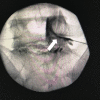Full-endoscopic Decompression of Foraminal Stenosis Caused by Facet Hypertrophy Contralateral to the Dominant Hand in a Baseball Pitcher: A Case Report
- PMID: 33062564
- PMCID: PMC7538464
- DOI: 10.2176/nmccrj.cr.2019-0075
Full-endoscopic Decompression of Foraminal Stenosis Caused by Facet Hypertrophy Contralateral to the Dominant Hand in a Baseball Pitcher: A Case Report
Abstract
Back pain and lower extremity pain have various causes and occasionally occur simultaneously, creating diagnostic difficulties. In addition, athletes require special consideration in terms of treatment. Here, we report a case of foraminal stenosis as a result of lumbar disc prolapse combined with facet hypertrophy contralateral to the dominant hand in a baseball pitcher that was successfully treated by minimally invasive full-endoscopic surgery. A 31-year-old left-handed male baseball pitcher presented with complaints of low back pain and right buttock pain while pitching. A diagnosis of foraminal stenosis caused by a disc bulge combined with facet hypertrophy contralateral to the dominant hand was made on the basis of physical and radiological findings. His symptoms improved immediately after transforaminal full-endoscopic lumbar discectomy and foraminoplasty under local anesthesia. He returned to play 3 months after surgery. Foraminal stenosis due to facet hypertrophy may occur in the side contralateral to the throwing arm in pitchers. Minimally invasive decompression using a full-endoscopic procedure is required for high-level athletes at this position.
Keywords: baseball player; facet hypertrophy; foraminal stenosis; full-endoscopic surgery; low back pain.
© 2020 The Japan Neurosurgical Society.
Conflict of interest statement
Conflicts of Interest Disclosure All authors report no conflicts of interest concerning this article.
Figures




Similar articles
-
Endoscopic foraminal decompression for failed back surgery syndrome under local anesthesia.Int J Spine Surg. 2014 Dec 1;8:22. doi: 10.14444/1022. eCollection 2014. Int J Spine Surg. 2014. PMID: 25694939 Free PMC article.
-
Transforaminal Percutaneous Endoscopic Discectomy and Foraminoplasty after Lumbar Spinal Fusion Surgery.Pain Physician. 2017 Jul;20(5):E647-E651. Pain Physician. 2017. PMID: 28727709
-
The Evolution and Advancement of Endoscopic Foraminal Surgery: One Surgeon's Experience Incorporating Adjunctive Techologies.SAS J. 2007 Aug 1;1(3):108-17. doi: 10.1016/SASJ-2006-0014-RR. eCollection 2007. SAS J. 2007. PMID: 25802587 Free PMC article.
-
Transforaminal endoscopic lumbar decompression & foraminoplasty: a 10 year prospective survivability outcome study of the treatment of foraminal stenosis and failed back surgery.Int J Spine Surg. 2014 Dec 1;8:21. doi: 10.14444/1021. eCollection 2014. Int J Spine Surg. 2014. PMID: 25694924 Free PMC article.
-
A novel surgical concept of transforaminal full-endoscopic lumbar undercutting laminectomy (TE-LUL) for central canal stenosis of the lumbar spine with local anesthesia : A case report and literature review.J Med Invest. 2019;66(3.4):224-229. doi: 10.2152/jmi.66.224. J Med Invest. 2019. PMID: 31656278 Review.
Cited by
-
Advantages of Full-endoscopic Trans-Kambin's Triangle Lumbar Interbody Fusion for Degenerative Spondylolisthesis: Illustrative Cases.NMC Case Rep J. 2023 Apr 10;10:87-92. doi: 10.2176/jns-nmc.2022-0287. eCollection 2023. NMC Case Rep J. 2023. PMID: 37131495 Free PMC article.
-
Short-term Clinical and Radiographic Outcomes of Transforaminal Full-endoscopic Pars Crisscross Decompression of the Exiting Nerve Root under Local Anesthesia in Adult Isthmic Spondylolisthesis.Neurol Med Chir (Tokyo). 2025 Jun 15;65(6):271-277. doi: 10.2176/jns-nmc.2024-0279. Epub 2025 Apr 7. Neurol Med Chir (Tokyo). 2025. PMID: 40189268 Free PMC article.
References
-
- d’Hemecourt PA, Gerbino PG, Micheli LJ: Back injuries in the young athlete. Clin Sports Med 19: 663– 679, 2000 - PubMed
-
- Bono CM: Low-back pain in athletes. J Bone Joint Surg Am 86-A: 382– 396, 2004 - PubMed
-
- Rajeswaran G, Turner M, Gissane C, Healy JC: MRI findings in the lumbar spines of asymptomatic elite junior tennis players. Skeletal Radiol 43: 925– 932, 2014 - PubMed
-
- Yamaguchi JT, Hsu WK: Intervertebral disc herniation in elite athletes. Int Orthop 43: 833– 840, 2019 - PubMed
-
- Yeung AT, Tsou PM: Posterolateral endoscopic excision for lumbar disc herniation: Surgical technique, outcome, and complications in 307 consecutive cases. Spine 27: 722– 731, 2002 - PubMed
Publication types
LinkOut - more resources
Full Text Sources
